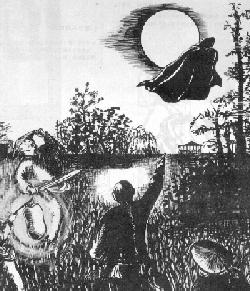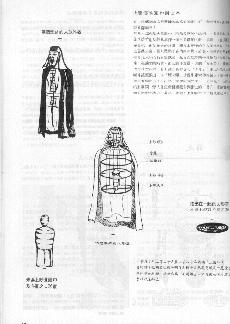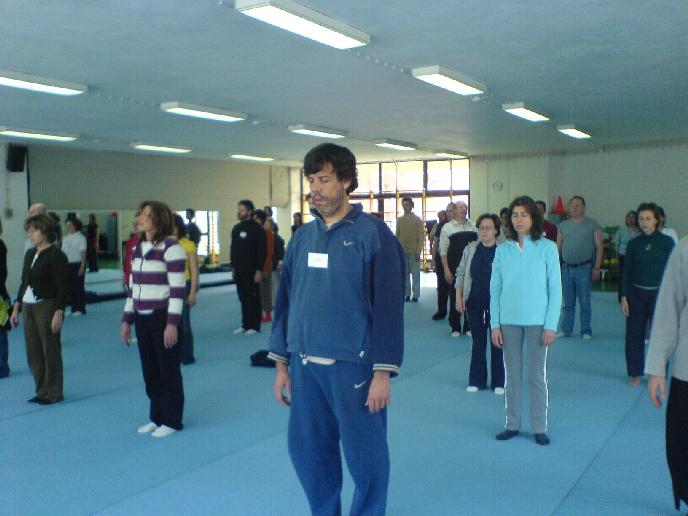August 2001 (Part 1)
SELECTION OF QUESTIONS AND ANSWERS

A picture showing a ninja flying into the sky as his pursuers closed in. Did he really fly into the sky? Ninjutsu, or the art of the ninja, originated in China where it was known as “renshu”, or “the endurance art”, and was popular amongst vagabonds. Because its methods were cunning and sometimes means, kungfu masters generally had a low oppinion of it. The picture shown above is taken from a book, “Skills of the Vagabonds”, compiled by Sifu Leong Ting, a well-known Wing Choon master.
Question 1
I'm 14 years old. I first had an interest in martial arts when I was 12 and I started doing kickboxing which I still do. I also do a bit of reading about samurai. My reading led me to Zen, a type of lifestyle they took up to enhance their ability on the battleground and to give them a carefree attitude towards life and death.
— Julian, Australia
Answer
I am much impressed with your maturity. When most people at 14 (including myself) think of having fun with their peers, you are thinking of such advanced topics like meditation and cultivating in a monastery. And you are sensible to say that you would do so, not now, but when you are older. When many adults write carelessly and often disorderly, you expressed yourself clearly and orderly. Are you a prodigy? It is a pleasure to share my experience and views with you.
I would like to give you my views on kickboxing and samurai. Please remember that they are only my opinions. You have to form your own conclusions.
I believe kickboxing, which may be suitable to some other people, is unsuitable for a prodigy like you. It is merely physical and too aggressive. The nature of its training is detrimental to your body, emotion and spirit. For example, you sustain injuries routinely left unattended to, you fight in frenzy, and you aim to defeat your opponent brutally. You should practise a martial art like genuine Shaolin Kungfu or Taijiquan, which is actually a complete programme for personal development.
A samurai was a warrior-servant to his lord. The samurai would do anything his lord dictated. If his lord asked him to kill his own mother, he would do so without question, and would be proud of it. The samurai had no feelings or thoughts of his own. A ninja was worse; he was a cold-blooded assassin. A samurai killed for loyalty; a ninja killed for money. The samurai philosophy was suitable for a stoic society adoring military might, but not suitable for an intellectual society valuing personal freedom.
It is a big mistake to equate samurai philosophy with Zen philosophy. In fact they are diagonally opposite in many ways. Samurai philosophy emphasizes obedience, ruthlessness, seriousness and disregard for life, whereas Zen philosophy emphasizes freedom, consideration, joyfulness and reverence for life.
Why, then, do many people relate the samurai to Zen? It is because the samurai employed many Zen techniques in his training and work. As an analogy, or extension, the Japanese employed Chinese techniques, such as in poetry, painting, medicine, government and architecture. But Japanese culture is very different from Chinese culture.
Question 2
I read your book, “The Complete Book of Zen”, and a few others. This has made me consider taking up Zen meditation. Unfortunately, there is nowhere nearby which covers it, so should I try it without a teacher or not?
Answer
You may try Zen meditation on your own for fun but you are unlikely to get good results. There are teachers in the West teaching Zen meditation, but in my opinion what they teach is so diluted that it has lost its meaning and essence. It is like chi kung and kungfu today, which are actually not real chi kung and real kungfu but some form of dance and gymnastics.
In the past, to be a Zen teacher one had undergone many, many years of training under a master. Now in the West it is not uncommon to find Zen teachers whose own training was nothing more than a week-end seminar. There are of course good Zen teachers in the West, but they are rare and you have to search for them.
You can practise and benefit from Zen in many other ways. If you can be aware of your present moment and live fully in it, you are practising Zen. That was why when a student asked his master what was Zen, the master replied, “Have you eaten your meal?”. Hence, when you next eat your meal, feel the texture of the food in your mouth and savour its taste. Most people don't do that; instead, they read the newspaper, think of their work, or gossip about their friends.
Question 3
Also, I'd like to follow my dream further, by moving to China or Japan or India for a certain amount of time and live in a monastery, this being when I'm old enough. Can my dream be followed, or is it just too unreal?
Answer
Generally speaking the people in China, Japan and India today are less inclined towards spiritual cultivation and more concerned with economic progress than people in the West. Even the temples, which were once centres of spiritual cultivation, are now converted to tourist attractions to earn foreign income. Nevertheless, there may be some temples or monasteries where genuine spiritual training is still possible. You would have to seek these temples.
Acceptance to these temples, even for local people, is not easy. If it is a genuine temple for spiritual cultivation, a person, especially a Westerner, will not be accepted just because he turns up at the temple door to say he sought enlightenment — a mis-conception many people in the West seem to have.
But spiritual cultivation needs not be carried out in a physical temple; it can be done in the temple of your heart. There are many ways to cultivate. One of the most effective, especially for those of your age, is to be kind and loving to your parents as well to elderly people. You will cultivate more blessings this way than praying in a physical temple or sitting in Zen meditation for hours.
Your spirit is closely related to your energy and your physical body. If your body is sick or your energy level is low, your spirit will be weak. Hence, to cultivate your spirit you must have health and vitality. Practising genuine Taijiquan or Shaolin Kungfu is an excellent way to cultivate your body, energy and spirit.

This page, taken from Sifu Leong Ting's book “Skills of the Vagabonds”, exposes the screts of the flying ninja. The flying object was not the ninja himself, but a dummy to divert the attention of the pursuers so that he could escape. It made use of rising stream to rise rapidly into the air.
Question 4
To attain enlightenment seems too appealing not to follow, and I know when I start saying stuff like that I have to watch where I step because Zen is supposed to promote letting go of values and desires or what not. But is this a possibility? To live in a monastery in one of those three countries and work to attain enlightenment when I'm old enough? It just seams so unreal.
Answer
Although many people talk about enlightenment, very few people understand what enlightenment means. Enlightenment, which is a Buddhist term, is the direct realization of cosmic reality. Different peoples from different cultures have described this highest spiritual attain in different words. Christians call it the return to God's Kingdom. Taoists call it merging with the Great Void.
Enlightenment is experiential, not intellectual. In other words, to attain enlightenment is to directly experience it, not merely to understand it intellectually like what we are doing now. The noble road to enlightenment is long and arduous, taking numerous lifetimes, though for those who are ripe they may attain it in an instant.
To say that Zen is letting go of values and desires is like saying in English "yes, no and thank you". It is oversimplifying Zen, or English, at a superficial level. Zen can be practised in many different ways. For you, one of the most effective ways to practise Zen is to be kind and loving to your parents and elderly people. Another effective way is to be keenly aware of your present moment.
Question 5
I hope that you can help me find out if a master that is teaching here in my country is genuine. He teaches taichi, qigong, san da and kung-fu (pak mei, ng chou, chang chuan, ditang, nanchuan). It seems odd to me that someone can teach so many different styles. Anyway he supposedly is Sifu at Pak Mei, Ng Chou Kuen and San Pin Nanchuan. Do you even know of this San Pin Nanchuan style?
— George, USA
Answer
You are right. It seems odd that someone can be good enough at so many different styles of kungfu to teach them effectively. Even if a master is good at many styles — which may be possible because kungfu skills are general and can be transferable to various styles when he is good at one — still he has one basic style that he is best at, and teaches it.
I know Pak Mei and Ng Chou Kuen, but have not heard of San Pin Nanchuan.
Question 6
From what I've seen his students know lots of forms but little application. I've been told that he only teaches traditional kungfu to senior students and the others learn mostly contemporary wushu. However it seems strange to me that in the examinations the students spar with boxing gloves, even the most senior ones.
Answer
You observed correctly. We can safely conclude that those who teach a lot of forms but little application, know little about kungfu and are not competent in combat.
His teaching senior students traditional kungfu and others wushu, suggests that he does not understand the philosophy, nature and purpose of kungfu and of wushu, and therefore is not likely to be a genuine master. If he were a master of kungfu, he would teach kungfu; if he were a master of wushu, he would teach wushu.
It would be odd if a person is a master of both kungfu and wushu because these two disciplines have diverting perspectives. Wushu exponents disregard combat efficiency, and aim at beautiful performance, whereas kungfu exponents disregard beautiful performance (though kungfu performances are also beautiful to watch), and aim at combat efficiency.
Even if a person were a master of both kungfu and wushu, he would not teach wushu to beginners first, and then teach them kungfu when they were advanced. Rather, he would teach wushu to one group who liked wushu, and kungfu to another group who liked kungfu.

Students practicing Standing Zen during a chi kung session
Question 7
I've practiced karate for some years and would like to learn kungfu, but not kungfu dance as you call it. Can you give me your opinion, Sifu?
Answer
Your choice is well made. I believe that genuine kungfu is far superior to karate. There are many reasons for my opinion. The following are just some of the reasons.
Karate is merely a fighting art, but kungfu is much more than a fighting art, it is a comprehensive programme for the exponents' development in all their physical, emotional, mental and spiritual dimensions. Karate masters would say their art is for comprehensive development too, but personally I do not think so.
Karate students often hurt themselves in sparring, and the injuries they sustained are routinely left unattended to. Even in solo training, the shouting and grimacing to appear fearsome, and the tensing of their body for muscular strength are detrimental to health.
On the other hand, kungfu students are seldom hurt in sparring. As kungfu emphasizes energy flow and discourages muscular tension, students are taught to be relaxed at all times, even while fighting. Kungfu training, which enhances jing, qi and shen (body, energy and spirit) brings good health, vitality and mental freshness.
Nevertheless, you have to train genuine kungfu, which is very rare, and not kungfu dance, which is popular. If genuine kungfu is not available, which is often the case, and you are faced with either kungfu dance and karate, your choice would depend much on your main objective.
If you want to learn a martial art, you should choose karate over kungfu dance. A kungfu dancer of many years could not defend himself against a karate blue-belt of a few months. But if your main objective is not combat but some socialization whereby you can also keep yourself agile and fit, kungfu dance would be a better choice; at least you won't injure yourself.
Question 8
I learned an exercise in Taijiquan called “beat hands” It is something like this. Partners face each other. Both people hit upward, right arms, then left arms. Then they both hit downward, right arms, then left arms. Then there is some type of twist step so partners are sideways, and hit each other's arms. Then they turn to face each other and repeat the whole thing. What exactly is this exercise called? I would like to know the history or origin of this exercise. Is there any book, video, website, etc. that shows how to do this exercise?
— Loretta, USA
Answer
The prototype of this exercise is called “Ta Sam Sing” which means “Hitting Three Stars”. “Ta Sam Sing” is in Cantonese, the dialect spoken by most practitioners who use this method of training. In Mandarin it is “Da San Xing”.
I do not know the history or origin of this exercise, but it is popular among exponents of Hoong Ka and other Southern Shaolin styles. In the standard version of “Ta Sam Sing”, two partners “sit” on the Horse-Riding Stance facing each other.
They swing their right arm at each other, knocking at the inside of the arm, next swing upward again knocking at the inside of the arm, then downward this time knocking at the outside of the arm. Then they repeat with the left arm. They continue this procedure until one of them withdraws. The main purpose of this exercise is to strengthen the arms.
There are variations to this standard version. One version, known as “Ta Chet Sing”, or "Hitting Seven Stars", involves more movements and changing of partners.
Such an exercise is generally not found in Taijiquan, which employs different philosophy and methods in strengthening the arms. Your Taijiquan teacher, or someone earlier in your generation-line, probably has incorporated this exercise from other kungfu styles.
“Ta Sam Sing” is considered “hard” force training, where the focus is on strengthening muscles and bones. Taijiquan employs “soft” force training, where the focus is on increasing energy flow. If you have learnt genuine Taijiquan from a master, any Taijiquan movement or pattern can be used to increase energy flow. “Grasping Sparrow's Tail” and “Lifting Water” are the two most widely used patterns by past masters.
“Hard” and “soft” here are poor translations of the Chinese terms “gang” and “rou”, and may not be what many Westerners conceptualize hard and soft to be. The “soft” force developed from “Grasping Sparrow's Tail” can be more powerful than the “hard” force developed from “Hitting Three Stars”.
Question 9
I have read your excellent book “The Art of Chi Kung”. Its philosophy is very close to me. I began to do practice every day in the morning and evening. After practising “Lifting the Sky” I began moving, and then I fell on my knees and elbows and froze. It was very pleasant, but when I tried to get up, my body didn't obey me. Maybe I did something wrong?
— Eleanor, Russia
Answer
You have not done anything wrong in your chi kung practice. Your reaction is normal. But the problem is that you are now approaching very powerful chi kung. If you practise wrongly in powerful chi kung, that can be serious. Right now you are fine; what I wish to warn is that you might make mistakes as you continue.
You are therefore left with two choices. One, you lower your level of training. If you keep at a lower level, your benefits will be less, but you will be safe. Two, you should learn from a master who teaches high level chi kung.
If you can afford the time and money, I would suggest you attend my Intensive Chi Kung Course to be held in Malaysia. As you have already shown promising results by practising on your own, the Intensive Chi Kung Course will open the way for your future development. You will be amazed at the benefits you will get.
